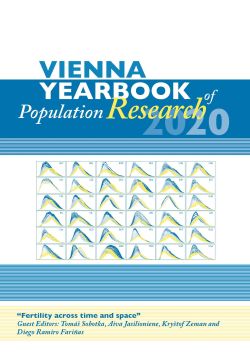
Vienna Yearbook of Population Research 2020, pp. 71-79, 2020/07/22
Fertility across time and space

Introduction: the relevance of studying fertility across time and space
Tomáš Sobotka
Debate
International political economy and future fertility trends
Alícia Adserà
Moving out the parental home and partnership formation as social determinants of low fertility
Albert Esteve, Diederik Boertien, Ryohei Mogi and Mariona Lozano
“Catching up with ‘compressed modernity”’ - How the values of Millennials and Gen-Z’ers could reframe gender equity and demographic systems
Stuart Gietel-Basten
Future fertility trends are shaped at the intersection of gender and social stratification
Trude Lappegård
The wish for a child
Anna Rotkirch
Fertility will be determined by the changing ideal family size and the empowerment to reach these targets
Wolfgang Lutz
Marriage will (continue to) be the key to the future of fertility in Japan and East Asia
Setsuya Fukuda
Review Article
Ultra-low fertility in East Asia: Confucianism and its discontents
Yen-hsin Alice Cheng
Research Articles
Laggards in the global fertility transition
David Shapiro, Andrew Hinde
Projecting future births with fertility differentials reflecting women’s educational and migrant characteristics
Michaela Potančoková, Guillaume Marois
Decomposing changes in first birth trends: Quantum, timing, or variance
Ryohei Mogi, Michael Dominic del Mundo
What factors support the early age patterns of fertility in a developing country: the case of Kyrgyzstan
Konstantin Kazenin, Vladimir Kozlov
Marital fertility decline and child mortality in the Sardinian longevity Blue Zone
Michel Poulain, Dany Chambre, Pino Ledda, Anne Herm
Future orientation and fertility: cross-national evidence using Google search
Nicolò Cavalli
Selected Wittgenstein Centre databases on fertility across time and space
Kryštof Zeman, Tomáš Sobotka